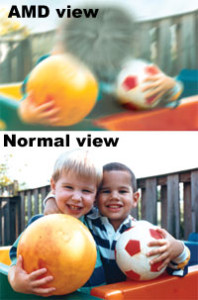 Age-Related Macular Degeneration is the most common cause of irreversible vision loss in the developed world in individuals over 65. Age-Related Macular Degeneration (AMD) occurs when the small central portion of the retina, known as the macula, deteriorates due to an amplification of the normal aging process, characterized by changes in the macular region, called drusen. The macular region, which is responsible for color vision and “20/20″ vision, is highly specialized and measures approximately 5.5mm in diameter.
Age-Related Macular Degeneration is the most common cause of irreversible vision loss in the developed world in individuals over 65. Age-Related Macular Degeneration (AMD) occurs when the small central portion of the retina, known as the macula, deteriorates due to an amplification of the normal aging process, characterized by changes in the macular region, called drusen. The macular region, which is responsible for color vision and “20/20″ vision, is highly specialized and measures approximately 5.5mm in diameter.
There are two primary forms of AMD: dry macular degeneration and wet macular degeneration. Dry AMD is much more common (90%) and usually does not cause significant vision loss, but can lead to wet AMD. Wet AMD (10%) leads to blindness, especially untreated. Some things that may help prevent this disease (or slow its progression) include: taking multivitamins, eating more leafy green vegetables (such as spinach, kale, broccoli, etc.), protecting the eyes with sunglasses, and not smoking.
Risk factors for AMD include:
- Age
- Race (most prevalent in Caucasians)
- Family history
- Smoking
- Obesity
- Ultraviolet exposure
- Hypertension
Symptoms of AMD include:
- A darkened area in a patient’s central vision
- Distorted vision
- Colors may begin to appear less vivid
It is essential for people that suffer from age-related macular degeneration to carefully monitor their eyesight and make regular visits to their eye doctor. An annual eye exam is imperative for early detection of AMD as treatment may delay or reduce the severity of the disease. Get ahead of the curve and please make an appointment to see your eye doctor at Johnson Optometric Associate. Ask us about AMD when you get here. We’re looking forward to your next visit with us.




